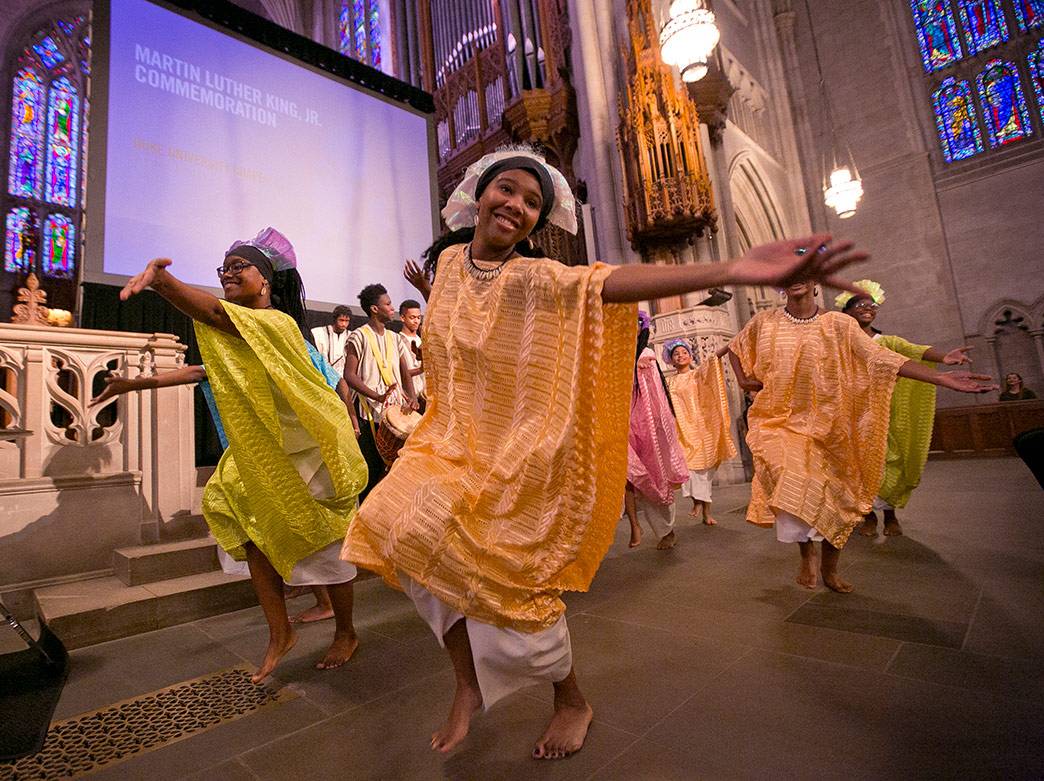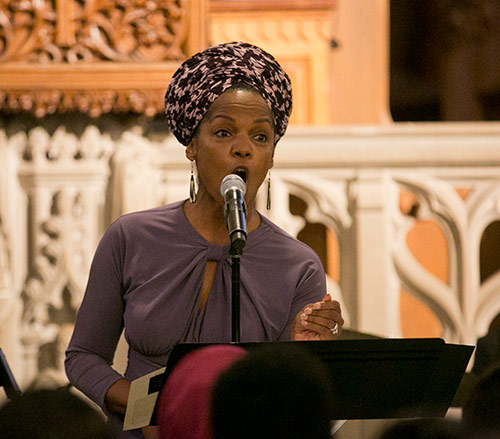On MLK Day, Thoughts on Capturing a Movement Through Architecture
African-American Museum designer Phil Freelon describes spaces inspired by history, welcoming to all

Durham’s Phil Freelon, the lead architect of the new National Museum of African American History and Culture, told a rapt Duke Chapel audience of more than 600 people Sunday to keep the Rev. Martin Luther King Jr.'s dream alive during this time he described as one of both opportunity and uncertainty.
“Each of us must find our own way to keep Dr. King’s dream alive and help move this nation toward his ideal vision of America,” Freelon said during Duke’s annual MLK commemoration service,.
Speaking from the chapel pulpit beside projected photographs, Freelon shared how a sculpture of a Yoruba king's crown became the inspiration for the new museum's “corona,” the signature exterior feature, made of 230 tons of bronze-colored aluminum panels, 3,600 in all, that are poised upon a base of transparent glass.
The design choice, drawn from the culture considered the proverbial roots of the majority of African-Americans, was made by an all-black architectural design team -- Freelon of Perkins + Will; London-based David Adjaye, and the late J. Max Bond Jr. of Davis Brody Bond of New York (plus the Washington, D.C. firm SmithGroup) -- who appreciated that the design would not resonate if it were derived from classical motifs.
While many of the buildings on the National Mall are marble, granite or concrete and lighter in color, Freelon said this building has a variation in how it appears and was designed to be “intentionally unique.” On certain days, in certain lighting conditions, it can be very vibrant and bright. And other times of the day or in the evening, it is darker.
The corona slopes upward and outward at an angle of 17 degrees, which Freelon said is the same angle that the Washington Monument rises upward and inward, so the two monuments talk to each other. And because the museum stands literally in the shadow of the monument, he said special attention was given to the construction of the below-ground floors and foundation so the nearby monument wouldn't be undermined.
Freelon's descriptions of the architectural elements of the museum were met at various points with applause, as when he noted a lens in the museum, set among the exhibits, frames the nearby Washington Monument.
The new museum was more than a century in the making, Freelon said, noting the contribution of U.S. Rep. and civil rights leader John Lewis at a key point in 2001. He said being involved in making it come to fruition was “the experience of a lifetime.”
Another Freelon design for the National Center for Civil and Human Rights in Atlanta features different brown tones to suggest the diversity of humankind and interlocking panels inspired by the interlocking arms of civil rights marchers, and indeed protesters internationally, who have taken up the stance to denote strength against adversity. “You can't use a fire hose to kick over people interlocked in this way,” Freelon said.
In both the Atlanta center and the new Smithsonian museum, Freelon pushed for spaces where people can gather and take action. In his introduction, Art and Art History Professor Richard Powell described Freelon as “an architect of the people” whose work is infused with “a soul and heart.”
This year's commemoration theme -- “building on a legacy of civil rights: arts, architecture and activism” -- was coupled with a statement noting that Dr. King was “an architect of peace and humanity.”
Freelon said African-American architect Julian Abele was an inspiration to him as a student at N.C. State University when he wrote an article in a professional journal that helped to publicize Abele's impact on the Duke campus. He said it was an honor to be speaking in a building of Abele's design.
Duke President Richard Brodhead, in remarks opening the service, encouraged the audience to walk past the plaque that was placed in the middle of the central West Campus quad last fall to honor Abele's contribution under challenging social conditions. Abele, the chief designer for Philadelphia’s Horace Trumbauer firm, led the design not just of West Campus in 1924, but also of many of the key architectural elements of East Campus, including Baldwin Auditorium.
Brodhead also celebrated the opening of the new Smithsonian museum, “the one with some jazz to it,” as a means for every school student who visits Washington to know that American history is also African-American history, “a history of struggle, triumph and much work left to be done.”
 Nnenna Freelon performs during Duke's MLK commemoration.
Nnenna Freelon performs during Duke's MLK commemoration.Durham Mayor Bill Bell said it was appropriate for Freelon to be recognized for a lifetime of work, and he offered well wishes to Freelon and his family as the architect battles amyotrophic lateral sclerosis (ALS), a fatal condition characterized by a loss of motor control.
Freelon, through the Freelon Foundation and the Design a World Without ALS campaign, has recently partnered with the Duke ALS Clinic to expand the university's capacity of tackle the disease.
Freelon, who walked into the chapel slowly and carefully with a cane, said he was delighted to be part of a program that included his wife, jazz singer Nnenna Freelon, who sang “Feeling Good” and a new song she composed with the words, “it is never too late when dreamers awake.” She was accompanied by John Brown and the University Jazz Ambassadors.
The chapel service was part of a week-long commemoration that also included a jazz concert featuring Dee Dee Bridgewater, a special Rubenstein Library display of West Campus architectural drawings by Abele, and continues today with student community-service projects.
In addition to the Duke Chapel service, the university also held a concert with the Duke Symphony Orchestra Saturday and sponsored a "Million Meals" packaging event with other institutions at Durham Tech. Read more here.